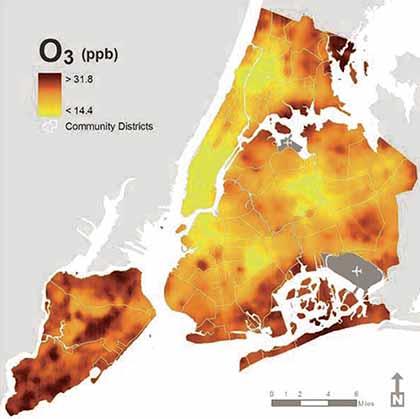By Philip Newman
It has long been established that thousands of cars and trucks create major pollution along New York City’s boulevards and highways, but it turns out that even quieter places like parts of Queens endure a dangerous, smog-like ozone.
The city Department of Health completed a study of summer air conditions throughout the city and the agency found that ozone concentrations were highest in downwind outerborough locations, such as the Rockaways and lower Staten Island.
Ozone results from chemical reactions among other pollutants such as nitrogen oxide in the presence of sunlight.
But in a curious finding, the report said the same pollutants that cause ozone can also remove it from the air, which means high traffic centers such as midtown Manhattan with heavy emissions often have less ozone than downwind areas.
Ozone pollution, which the department said can aggravate asthma, was also detected in Howard Beach, Broad Channel, parts of Jamaica and St. Albans, College Point and Douglaston.
“It’s important to remember that all New Yorkers have a stake in improving the city’s air quality,” said Dr. Thomas Farley, the city health commissioner.
“Exposure to the pollutants evaluated in this report can cause grave health problems, including cardiovascular and lung diseases and premature death,” Farley said.
“This study reiterates the need to switch to more fuel-efficient cars, reduce car traffic and increase the use of public transportation,” Farley said. “We must also continue efforts to make the city an even easier and safer place to walk and bike. All this will protect the air we breathe.”
The report, conducted last summer, said any city neighborhood adjacent to busy highways was a major air pollution area.
“Street designs that enhance safety and ease congestion build a healthier New York,” said city Transportation Commissioner Janette Sadik-Khan. “Through traffic calming projects, dedicated bus lanes and improved room to walk and bike, we are transforming our streets into livable spaces where New Yorkers can be more active outdoors.”
The report said another solution to reducing harmful emissions is to expand mass transit options to help achieve the clean air goals set out in PlaNYC in 2007 to improve the city’s air quality. The results of the city Community Air Survey are part of PlaNYC and involve sampling the air at 150 street-level locations in every season.
Reach contributing writer Philip Newman by e-mail at timesledgernews@cnglocal.com or phone at 718-260-4536.

































